*Originally published by Phreesia. To learn more about Phreesia Life Sciences, visit lifesciences.phreesia.com.
While point of care has traditionally been considered a “reminder channel,” or a final touchpoint to reinforce mass-media messaging to patients before their doctor’s appointments, it can achieve so much more. Digital innovations, coupled with the channel’s proximity to crucial doctor-patient conversations, have expanded its use cases and it now offers opportunities that range from boosting disease education to supporting product launches and promoting patient support programs, among other key capabilities.
This report features insights and advice from six industry experts on how to effectively use point-of-care marketing across various stages of the patient journey and product lifecycle to maximize its impact within your omnichannel media strategy.
Hear from these experts:
- Jennifer Tesoroni, VP, Director of Multichannel Media, SSCG Media Group
- Seth Mellin, Associate Director of Point of Care, Publicis Health Media
- Italia Marr, Associate Media Director, Greater Than One
- Christine Mormile, Media Director, CMI Media Group
- Dave Leitner, EVP, Head of Media, Klick Health
- Jason Celestino, Lead Client Experience Manager, Phreesia Life Sciences
Introduction
The point of care has traditionally been considered a “reminder channel”—in other words, a final touchpoint before a doctor’s appointment to reinforce mass-media messaging patients have already engaged with elsewhere.
But while point of care can certainly do that, it can achieve much more, thanks in large part to digital innovations that have revolutionized the channel in recent years. Patients are already in a healthcare mindset at the point of care and can take action within moments of exposure to an ad. And between the channel’s proximity to crucial doctor-patient conversations and its new digital capabilities, use cases have multiplied.
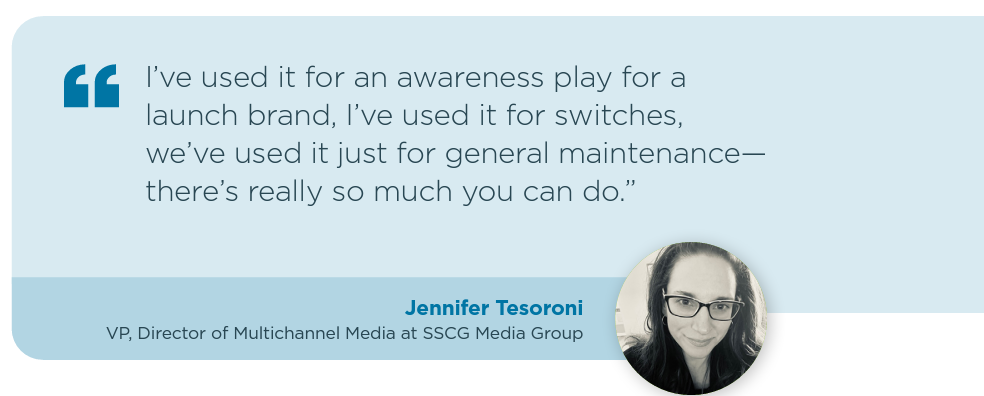
“I’ve used it for an awareness play for a launch brand, I’ve used it for switches, we’ve used it just for general maintenance— there’s really so much you can do,” says Jennifer Tesoroni, VP, Director of Multichannel Media at SSCG Media Group.
So how can these opportunities be integrated into omnichannel media strategies to maximize their impact? Read on for expert advice on how to effectively use the point of care across various stages of the product life cycle and the patient journey.
Provide disease education
Provide disease education While the point of care is often home to branded ads, it can also be a very effective venue for providing unbranded disease education and empowering patients to engage in shared decision making with their providers.
“The point of care is a great place to give patients that last bit of information to help them understand their condition and diagnosis so that they’re able to think about and discuss their symptoms and treatment options with their doctor,” says Seth Mellin, Associate Director, Point of Care at Publicis Health Media.
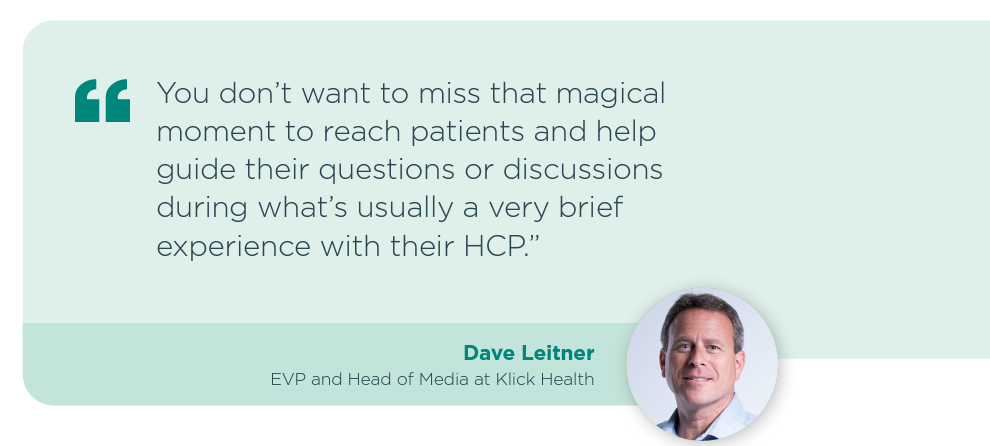
Before an appointment is also an ideal time to supply patients with educational tools such as doctor discussion guides and symptom trackers. Armed with these relevant resources, patients will be “informed and ready to control some of that conversation with the HCP, versus the HCP just going down a list of questions,” says Dave Leitner, EVP and Head of Media at Klick Health.
“You don’t want to miss that magical moment to reach patients and help guide their questions or discussions during what’s usually a very brief experience with their HCP,” he adds.

Support a product launch
The benefits of point-of-care messaging for a launch brand are easy to see. “Point of care is a great channel to spread awareness of ‘Now approved’ messaging and help facilitate discussion between the HCP and patient in-office,” says Italia Marr, Associate Media Director at Greater Than One. “What better time to let patients, caregivers and HCPs know about your product than when they are about to have a consult for the very condition it treats?”
Point-of-care advertisers also ensure theirs is the last message a patient sees before heading into the exam room, whether physical or virtual—and that advantage can be especially powerful for brands that don’t necessarily have the capability to outspend competitors that have been around for years.
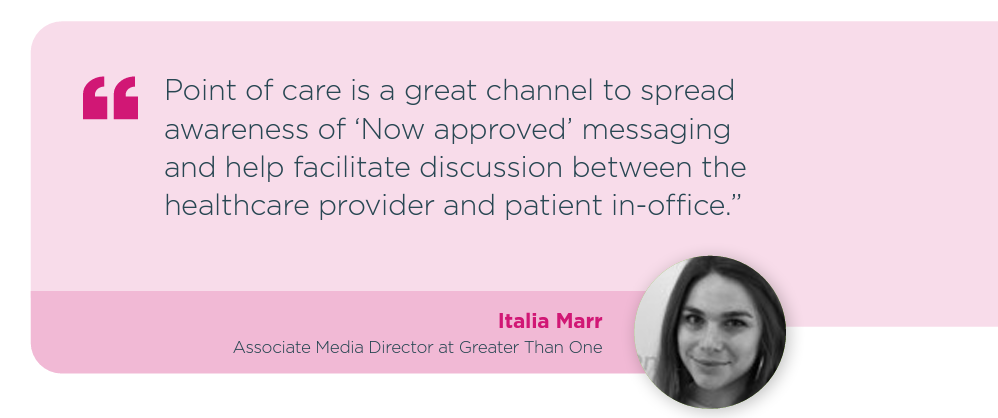
“If you can come into the market and reach patients at the point of care, which is the last touchpoint before they’re about to talk to their doctor, it doesn’t really matter how long that other brand has been out or how much money they spent on all this other mass media,” says Jason Celestino, Lead Client Experience Manager at Phreesia Life Sciences. “If you’re the last brand patients have heard of, you’re top of mind before they talk to their doctor.”
Spotlight on: Raising awareness
One problem with pigeonholing point of care as a reminder channel? In many cases, brand awareness and recall are much lower than brands might expect by the time patients near their doctor’s appointment.
In fact, data from a recent Phreesia survey administered at the point of care showed that just 5% of patients with a specific health problem recognized a leading brand for their condition, despite a TV ad spend for that brand of more than $280 million. In a separate Phreesia survey, 31% of polled patients said they couldn’t recall a single asthma drug brand name after more than 21 billion TV impressions in the category.
“So many patients, by the time they get to the point of care, don’t really have brands top-of-mind,” says Jason Celestino, Lead Client Experience Manager at Phreesia Life Sciences. “Point of care truly is more than just a reminder channel—it’s an awareness channel.”
Messaging at the point of care also offers patients an opportunity to start spur-of-the-moment conversations with their physicians about brands they aren’t necessarily familiar with, Seth Mellin, Associate Director, Point of Care at Publicis Health Media, notes.
“Sometimes I like to think of it as being in the grocery store at the register,” he says. “You didn’t go for M&Ms, but they’re there at that last minute. So now patients may not have even been going in there to talk about your brand, but they see your brand and all of a sudden they have that discussion.”
Promote patient support programs
The ability of select digital platforms to reach patients along the patient journey can also get crucial support resources into the hands of patients who need them.
With point of care, “there are lots of ways to say, ‘Where does the product sit within the journey overall, and then how do I make that messaging relevant and sequence that?” Leitner says. That may look like serving a patient information about a support group after they’ve received a diagnosis to help relieve feelings of loneliness or isolation.
Or it might look like delivering a savings offer after a prescription has been written, which can lead to better medication adherence and better overall health outcomes.
Spotlight on: Creative strategy
Jennifer Tesoroni, VP, Director of Multichannel Media at SSCG Media Group, has seen clients consider repurposing ads from other channels at the point of care—but it’s a move she always discourages.
No matter the stage of a product’s life cycle, “Having very specific messaging for point of care is important,” she advises. “That’s our one opportunity to be able to make an impact, so we want to make sure it’s not wasteful.”
Instead of “taking a general banner and plopping it in,” she recommends thinking through the healthcare journey to determine what message will resonate with patients, as well as what resources they’ll find most useful.
Italia Marr, Associate Media Director at Greater Than One, agrees that thoughtful messaging is paramount. “Aligning the right content with the right context is powerful,” she says.
Identify patients for switch
Platforms that can reach patients based on their medication history also can help brands convert patients from competing drugs.
The point of care provides a moment for patients to say, “Hey doc, I’m on Rx A, and I just saw in an ad in the waiting room that there’s something new on the market. The ad mentioned no increased weight gain or other side effects. Can you tell me more about it, as I may want to switch to this new brand?” Leitner says.
Of course, most of the time, initiating a behavior change doesn’t happen overnight, so that’s where it’s important to have a mix of channels, Tesoroni advises. But it’s “equally important to get the patient when they’re getting ready to go in to see the doctor.”
Spotlight on: Digital transformation
If there’s one thing to know about point of care, it’s that its capabilities have evolved immensely in a short period of time, says Italia Marr, Associate Media Director at Greater Than One. “What used to be strictly print materials now includes all things digital,” she says.
While those print materials still have a place in physical waiting rooms, with the acceleration of telehealth, the point of care is no longer confined to the four walls of the office—and that expansion has brought a host of new opportunities to reach patients, including options to follow up after a visit via text or email.
Telehealth is evolving how point of care works and functions, says Christine Mormile, Media Director at CMI Media Group. “If anything, I’m excited to continue to amplify and evolve my point-of-care strategies just because it’s continuing to change so much through the way our patients and doctors are communicating with one another on an ongoing basis.”
Dave Leitner, EVP and Head of Media at Klick Health, expects to see that trend grow as remote patient monitoring becomes more widespread and wearables feed a continuous stream of data to providers. “It’s going to translate into more moments where patients and HCPs need to connect, which should create more opportunities that serve point of-care messaging,” he says.
Promote a mature brand
Point of care can be a very important channel for brands well beyond the launch phase, Tesoroni says, noting that her team has “used it even for brands in a very, very mature state.”
If you’ve “been in the marketplace for a while, you want to remind everyone that you’re around, you’re still a good treatment option, and that sometimes tried and true is better,” says Christine Mormile, Media Director at CMI Media Group. “It’s very easy to look at the shiny new object and assume it’s better for you.”
For products that are even closer to the end of their life cycle, the point of care can be a great place to sunset a brand and introduce a new one through a migration campaign, Celestino notes.
There’s also a practical reason to include point of care as a brand matures and priorities shift, he points out. “At this point in your product’s lifecycle, chances are budgets are getting slimmer and there’s a need to focus on efficiency. Between rapidly increasing TV costs and consumer privacy concerns leading to data restrictions that negatively impact the audience quality of digital tactics, mass media is probably not going to deliver the efficiency you’re looking for.”
For Tesoroni, efficiently promoting a mature brand means thinking about what will matter most to a patient when they go to their pharmacy to fill a prescription. Their biggest question is likely to be, “‘Is this medication going to be covered under my current plan?’” she says. To get ahead of those concerns, she recommends targeting patients with plan-specific messaging that reassures them that a brand is covered by their insurance.
Retain patients
The point of care can be a useful setting not only for converting new patients, but for retaining current patients, too. Particularly as insurance companies put pricing pressure on brands, adherence is “something everyone struggles with,” and in Mormile’s opinion, probably the biggest area of opportunity for point of care.
“As we think forward, some of the areas of opportunity are really going to be not only announcing your brand, but really keeping your brand top of mind,” she says.
For a product that’s further along in its life cycle, there’s a higher probability that a patient in the office is already using it. So, it’s important to affirm a product’s positive effects so that patients know they should stay on it.
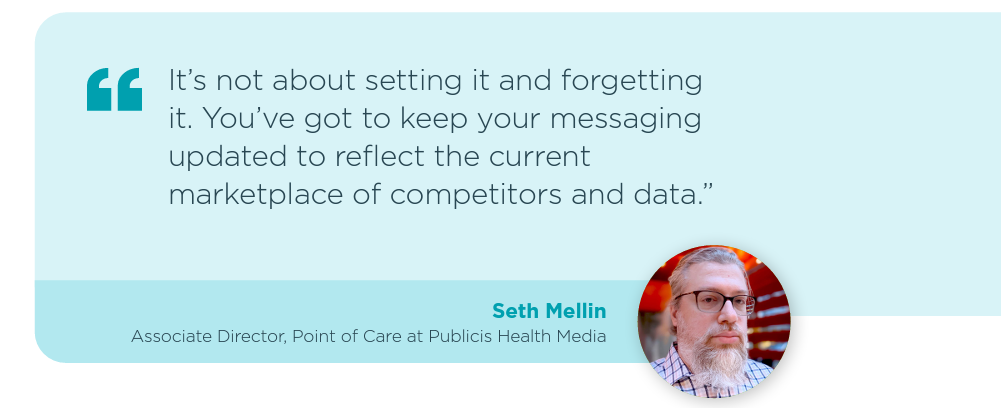
To that end, it’s vital to keep the information in your messaging current, Mellin notes. “It’s not about setting it and forgetting it. You’ve got to keep your messaging updated to reflect the current marketplace of competitors and data.” He recommends using clinical trial data and real-world patient stories to keep patients on brand. Those consistently resonate with patients and help them feel positive about the brand they’re on, he says.
Key takeaways
The point of care is a versatile channel, and with the right mix of tactics, it can be leveraged to implement a range of strategies that align with their brand goals.
Leaving it out of your omnichannel approach, on the other hand? That’s akin to “missing that last piece of the puzzle that is your media plan,” Mellin says. A lot of your efforts “are on driving the patient to the doctor, and if you’re forgetting the point of care, you’re not closing that loop.”
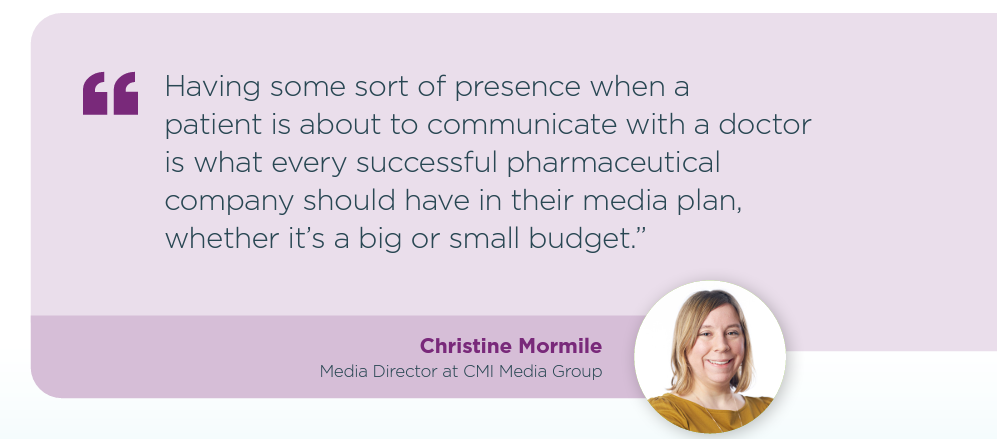
Particularly in an age of immense clutter and competition, messaging in the moment is key, Mormile agrees. Reaching a patient just before a doctor’s appointment is “mission critical to increasing scripts, and having some sort of presence when a patient is about to communicate with a doctor is what every successful pharmaceutical company should have in their media plan, whether it’s a big or small budget.”
